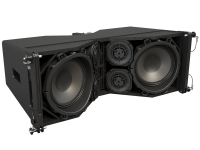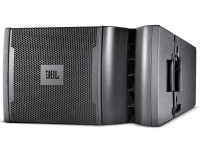ABOUT THE PRODUCT
ABOUT THE MANUFACTURER
GLOSSARY
VRX932LA
12 in. Two-Way Line Array Loudspeaker System
The VRX932LA-1 is a light-weight (46 lb / 21 kg) compact 12" two-way line array speaker system designed for use in arrays of up to six units.
Features
- JBL's exclusive neodymium magnet Differential Drive? woofer for high-power capacity and light-weight.
- VRX932LA-1 features 3 x 2408J Annular Ring Diaphragm HF drivers. The 2408 represents the latest in JBL Professional compression driver design.
- Constant Curvature waveguide for unprecedented array coherence.
- Dual angle pole socket for aiming flexibility. One or two speakers may be mounted to a 35 mm pole or tripod stand.
- Integral rigging hardware for simple connection of enclosures and optional array frame. Arrays of up to six enclosures may be flown.
- Array Configuration selector permits ?array shading? in passive mode.
VRX918S
18 in. High Power Powered Flying Subwoofer
The VRX918SP is a powered, suspendable subwoofer system containing a 2268FF neodymium magnet, patented Differential Drive, 18" woofer in a front-loaded, vented enclosure. The VRX918SP was designed specifically for use in arrays with the VRX932LAP Line Array speaker and VRX-AF Array Frame. In addition it may also be used in arrays consisting entirely of VRX918SP subwoofers.
Features:
- Built-in JBL Drivepack DPC-2 amplifier module designed by Crown provides 1500 Watts of peak Power. DSP based resident input module provides system optimization, EQ and crossover functionality.
- 18 inch, 2268FF dual voice coil, neodymium magnet Differential Drive woofer for high-power capacity and light weight.
- Integral rigging hardware for simple connection of enclosures and optional array frame.
- 20 mm threaded pole socket for solid, secure satellite speaker mounting.
- Large port area for reduced distortion.
SRX718S
1x18" High Power Subwoofer
The SRX718S subwoofer`s compact design is equally at home as a small, high-performance satellite subwoofer system or as a building block for larger subwoofer arrays.
- 18 inches, 2268H Differential Drive woofer for extended low-frequency output.
- Large port area for reduced distortion.
- 20 mm threaded pole socket for solid, secure satellite speaker mounting.
Professional used lighting equipment.| Professional second hand lighting equipment.| Professional pre owned lighting equipment.
Professional used audio equipment.| Professional second hand audio equipment.| Professional pre owned audio equipment.
Second hand audio gear. | Second hand lighting.
Pro audio equipment, second hand amplifiers, DJ, second hand sound systems, second hand Microphones, second hand Media Players.
Outdoor & Indoor LED screens for sale, LED mobile truck.
Light trussing, Gebrauchte Veranstaltungstechnik, used stage equipment Stage & Theatre lighting products.
Used JBL
JBL is an American company that manufactures audio equipment, including loudspeakers and headphones. There are two independent divisions within the company; JBL Consumer produces audio equipment for the consumer home market, while the JBL Professional produces professional equipment for the studio, installed sound, tour sound, portable sound (production and DJ), and cinema markets. JBL is owned by Harman International Industries, a subsidiary of South Korean company Samsung Electronics.
JBL was founded by James Bullough Lansing (1902–1949) who was an American audio engineer and loudspeaker designer most notable for establishing two audio companies that bear his name, Altec Lansing and JBL, the latter taken from his initials.Early products included the model 375 high-frequency driver and the 075 ultra high frequency (UHF) ring-radiator driver. The ring-radiator drivers are also known as "JBL bullets" because of their distinctive shape. The 375 was a re-invention of the Western Electric 594 driver but with an Alnico V magnet and a four-inch voice coil. The 375 shared the same basic magnet structure as the D-130 woofer. JBL engineers Ed May and Bart N. Locanthi created these designs.
In 1955 the brand name JBL was introduced to resolve ongoing disputes with Altec Lansing Corporation. The company name "James B. Lansing Sound, Incorporated", was retained, but the logo name was changed to JBL with its distinctive exclamation point.
The JBL 4320 series studio monitor was introduced through Capitol Records in Hollywood and became the standard monitor worldwide for its parent company, EMI. JBL's introduction to rock and roll music came via the adoption of the D130 loudspeaker by Leo Fender's Fender Guitar Company as the ideal driver for electric guitars.
In 1969, Thomas sold JBL to the Jervis Corporation (later renamed "Harman International"), headed by Sidney Harman. The 1970s saw JBL become a household brand, starting with the famous L-100, which was the best-selling loudspeaker model of any company to that time. The 1970s were also a time of major JBL expansion in the professional audio field from their studio monitors.
By 1977, more recording studios were using JBL monitors than all other brands combined, according to a Billboard survey.[5] The JBL L-100 and 4310 control monitors were popular home speakers. In the late 1970s, the new L-series designs L15, L26, L46, L56, L86, L96, L112, L150, and later the L150A and flagship L250 were introduced with improved crossovers, ceramic magnet woofers, updated midrange drivers, and aluminum-deposition phenolic resin tweeters.
In the mid-1980s the designs were again updated and redesigned with a new titanium-deposition tweeter diaphragm. The new L-series designations being the L20T, L40T, L60T, L80T, L100T, the Ti-series 18Ti, 120Ti, 240Ti, and the flagship 250Ti. To test speaker drivers, JBL in Glendale and Northridge used the roof as an outdoor equivalent to an anechoic chamber.
Over the next two decades, JBL went more mass-market with their consumer (Northridge) line of loudspeakers. At the same time, they made an entry into the high-end market with their project speakers, consisting of the Everest and K2 lines.
JBL became a prominent supplier to the tour sound industry, their loudspeakers being employed by touring rock acts and music festivals.
JBL products were the basis for the development of THX loudspeaker standard, which resulted in JBL becoming a popular cinema loudspeaker manufacturer.
Professional used lighting equipment.| Professional second hand lighting equipment.| Professional pre owned lighting equipment.
Professional used audio equipment.| Professional second hand audio equipment.| Professional pre owned audio equipment.
Second hand audio gear. | Second hand lighting.
Pro audio equipment, second hand amplifiers, DJ, second hand sound systems, second hand Microphones, second hand Media Players.
Outdoor & Indoor LED screens for sale, LED mobile truck.
Light trussing, Gebrauchte Veranstaltungstechnik, used stage equipment Stage & Theatre lighting products.
Octave: The difference between two frequencies where one is twice the other. For example, 200 Hz is an octave higher than 100 Hz. 400 Hz is one octave higher than 200 Hz.
Optical Digital Cable: Fiber optic cable that transfers digital audio signals as light pulses.
Outcue/Outq/Out-Point: These words all refer to the final few seconds of audio signifying the conclusion of the production.
Package: A completed and fully edited audio piece.
Passive: Not active. A passive crossover uses no external power and results in insertion loss. A passive speaker is one without internal amplification.
Phase: Time relationship between signals it’s all relative.
Power Output: A measure, usually in watts, of how much energy is modulated by a component.
Preamplifier: A control and switching component that may include equalization functions. The preamp comes in the signal chain before the amplifiers.
Pre Outs: Connectors that provide a line-level output of the internal preamp or surround processor.
Pre Outs/Main Ins: Connectors on a receiver that provide an interruptible signal loop between the output of the internal preamp or surround processor portion of the receiver and the input of the amplifier portion of the receiver.
Pre/Pro: A combination preamp and surround processor.
Processors: Anything that processes an incoming signal in some way. Surround processors, for example, can decode a Dolby Digital signal to send to an amp so you can hear it.
Pulse Code Modulation: (PCM) a way to convert sound or analog information to binary information (0s and 1s) by taking samples of the sound and record the resulting number as binary information. Used on all CDs, DVD-Audio, and just about every other digital audio format. It can sometimes be found on DVD-Video.
Q-and-A: Question and answer session.
Receiver: Any component that receives, or tunes, broadcast signals, be it NTSC, HDTV, DBS, or AM/FM radio. Typically refers to the single component that includes a preamp, surround processor, multichannel amplifier, and AM/FM tuner.
Reverberation: The reflections of sound within a closed space.
RF: Radio Frequency. Television signals are modulated onto RF signals and are then demodulated by your television’s tuner. VCRs and DBS receivers often include channel 3 or 4 modulators, allowing the output signal to be tuned by the television on those channels. Also, laser discs used an RF signal for modulating Dolby Digital 5.1 soundtracks on some movies. This requires an RF demodulator (usually referred to as an AC3-RF demodulator) before or in the surround processor to decode the signal.
RMS: Root Mean Square or the square root of the arithmetic mean (average) of the square’s set of values. A reasonably accurate method of describing an amplifier`s power output.
SACD: Super Audio CD. Enhanced audio format with up to six channels of high-resolution audio encoded using DSD. Requires an SACD player. Multichannel also requires a controller with six-channel analog or proprietary digital inputs for full playback.
Sampling Frequency: How often a digital sample is taken of an analog wave. The more samples taken, the more accurate the recording will be. You need to sample at a minimum of twice the highest frequency you want to capture. For example, the 44.1-kilohertz sampling rate of a CD cannot record sounds higher than 22.05 kilohertz.
Scener: A radio report in which the announcer is recorded at the same time and place as the background sound of an event.
Sensitivity: A measurement (in dB) of the sound-pressure level over a specified frequency range created by a speaker driven by 1 watt (2.83V at 8 ohms) of power with a microphone placed 1 meter away.
Signal-to-Noise Ratio: A comparison of the signal level relative to the noise level. Larger numbers are better.
Simultaneous Interpretation: This system allows attendees to hear the meeting in their own language.
Sound Bite: A portion of audio of someone speaking.
Sound field: The total acoustical characteristics of a space, such as ambience number, timing, and relative level of reflections ratio of direct to reflected sound RT-60 time etc.
Soundstage: The area between two speakers that appears to the listener to be occupied by sonic images. Like a real stage, a soundstage should have width, depth, and height.
Speaker: A component that converts electrical energy into acoustical energy.
SPL: Sound-Pressure Level. Measured in dB.
Subwoofer: A speaker designed to reproduce very low bass frequencies, usually those below about 80 Hz.
THX: Certification program for home theater equipment. Uses some proprietary features, but mostly assures a base quality level for a given room size. (See THX select or Ultra.) Is compatible with any and all soundtrack formats. Stands for either Tom Holman’s eXperiment, after the engineer who drafted the original standard, or is named after the company’s founder George Lucas first movie, THX 1138. Nobody agrees on which.
THX select: Certification program for speakers and receivers that assures a base level of quality and performance when played in a room that’s between 2,000 and 3,000 cubic feet.
User-Generated Content (UGC): Text, photos, video or audio supplied by the customers of a company.
Voicer: A radio report without background audio taken from a scene or otherwise.
Wrap: A radio report containing both the reporter and an actuality.
Professional used lighting equipment.| Professional second hand lighting equipment.| Professional pre owned lighting equipment.
Professional used audio equipment.| Professional second hand audio equipment.| Professional pre owned audio equipment.
Second hand audio gear. | Second hand lighting.
Pro audio equipment, second hand amplifiers, DJ, second hand sound systems, second hand Microphones, second hand Media Players.
Outdoor & Indoor LED screens for sale, LED mobile truck.
Light trussing, Gebrauchte Veranstaltungstechnik, used stage equipment Stage & Theatre lighting products.































